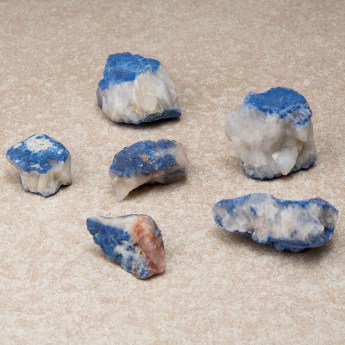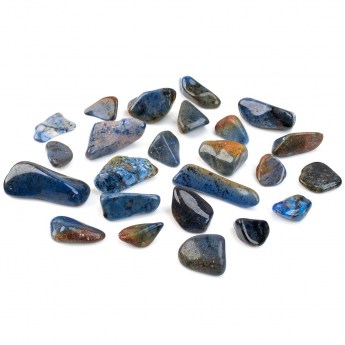Dumortierite: Properties, Facts and Photos

What is Dumortierite?
Dumortierite is a borosilicate mineral, often found as inclusions within quartz, which gives rise to the term dumortierite quartz.
While the host mineral is quartz, the distinctive blue or violet colour comes from the dumortierite crystals. When these inclusions are abundant, they can make the stone appear opaque.
Dumortierite typically forms fine prismatic crystals. These crystals have an elongated shape with flat, parallel faces running along their length.
Although dumortierite crystals are commonly blue, they can also be violet, bluish-violet, brown, red, and pink.
Dumortierite is a boro-silicate mineral, meaning it's composed of the chemical elements boron and silicon. After oxygen, silicon is the most common element in Earth's crust.
Tourmaline is the most abundant borosilicate mineral, with dumortierite coming a close second. However, dumortierite remains relatively understudied.
Dumortierite is sometimes mistaken for sodalite and has also been used to imitate lapis lazuli, which is far more scarce.
Dumortierite occurs in metamorphic rocks rich in aluminium. The finest grade, which can be exceptionally beautiful, often features a mass of long, slender crystals embedded within clear, colourless quartz.
Dumortierite crystals have a vitreous lustre, are generally quite small, and may exhibit pleochroism with colours varying from red to blue to violet.
Dumortierite was named after Eugène Dumortier but was not, as some references state, discovered by him. Dumortier was a French palaeontologist and geologist [1803 - 1873]. This newly discovered mineral was named after him in 1881 to honour his work in the region where it was found.
Since its discovery, dumortierite has been found in more than forty countries worldwide.

Dumortierite Pronunciation
Over the years, I've come across some interesting pronunciations of the mineral dumortierite. I recently heard someone refer to it as 'dumorcherite,' which got me thinking about how it should be pronounced correctly.
With dumortierite being named after Frenchman Eugène Dumortier, I believe it should be pronounced 'dumor~ti~air~rite'. This seems logical, considering that according to the rules of French, his surname would have been pronounced dumor~tee-air.
The suffix 'ite' is often used when minerals are named after a person or place. Examples include labradorite, unakite, mookaite and Englishite.
This suffix was first used by the ancient Greek philosopher Aristotle [384 BC - 322 BC] for the mineral hematite (Greek; haematitis), which he described as 'dried and condensed blood.'
The names of many minerals are often mispronounced. A good example is sugilite, which is almost always pronounced with a soft g, as in 'genius', instead of with a hard g, as in 'gun'. A hard g should be used because sugilite was named after a Japanese professor named 'Sugi', pronounced with a hard g.
The pronunciation of dumortierite on Mindat, the world's largest mineralogical database, is probably how most people say it.
Here's the recording. Scroll down to 'Pronunciation of Dumortierite.'

Article Pictures
The first photograph in our article is dumortierite in pyrophyllite. It's housed in London's Natural History Museum and comes from Namibia in southwest Africa. Photo by Stone Mania.
The second photo is of terminated quartz crystals with fine inclusions of dumortierite. Photo courtesy of Stan Celestian.
The dumortierite on quartz rough stones are from our collection.
Most photos are clickable and redirect to the original image.
Pop-up image: Sodalite: Courtesy of Alan English. Lapis Lazuli: Courtesy of James St. John. Sugilite: Courtesy of Géry Parent.














